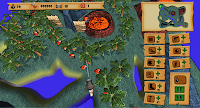***
Last March of the Dodos
Not much to say this week due to Spring Break. Ugh. We really need all the time we can get, and this break certainly didn't do much to help us. I did plan out a few more achievements, and Derek did fix some bugs and make additions to the achievement code, but we were pretty sparse other than that.
A Videogame With/out Rules
As expected, we didn't have any official team meetings this week. However, those of us who were in town did manage to get quite a bit done. Josh and Chris did a great job pumping out mockups of what will become our final overlays. Meanwhile, Wang figured out how to get extra controllers working for the game, so we can have up to four players at once (or just four movable sprites that people can position around the gamespace, depending on the rules). We're still working to get four actual joysticks functioning, so we'll keep you updated on that front.
I had a meeting with Al to determine the best way to physically present the game in a museum space. We discussed several ideas that we had come up with as a team, including building the game into an arcade cabinet and simultaneously projecting the on-screen visuals onto a large wall, building a podium for the controls and displaying the game on a large wall-mounted screen, and even setting up the space to feel like a '70s living room. The one we're leaning toward is the podium and large screen, but there is still a chance that could change. It simply allows a very open, public experience to occur, and we can put text and image vinyls on the walls around the screen to give additional context to the exhibit.
However, whatever form the physical presentation takes, it will include a display case bearing an original Magnavox Odyssey...which arrived this week! Check out this unboxing video of our very own 41-year-old Odyssey console, complete with all the extra tokens and overlays it originally contained. (Pardon the view orientation. It was recorded with a smart phone, and Rachel wanted the focus of the viewable area to include my body language and all the goodies inside the box.)
Reveal
It was actually a good week for Reveal. We had most of the team here, and we even had a few sessions all together. It's pretty much just coming down to populating the levels Jason has built with the art assets and prefabs. The mechanics are there, and I can't wait to present what we've got working!
Personally, I've been working on the animations for the main character. I've had a bit of trouble working with the rig (I am no expert at rigging, so any snags I run into on that front have me running back to Isaac for help), but I got a walk cycle done and I'm moving on to the run and dodge reels.
The Macromancer
As a team, we spent a day jamming out a bunch of work on The Macromancer. We took the opportunity to refine our camera and player controls, as well as to get our enemy AI performing more like we envisioned (still plenty of refining to do). It's still fairly rough, but the game steadily moves forward. Also, Eric is knocking out art that we'll soon be dropping into the game. I tell ya, it feels great to get fun art actually functioning in a game; can't wait to see that art in action soon!
The real news here, however, is that we've decided to change it from a 3D action-puzzle-platformer to a 2.5D one. We just feel that with our resources, we can build a tighter, higher quality experience by eliminating one dimension of gameplay (still 3D art assets). All the mechanics remain, so I'm excited to see how this new direction shapes up!
Elders of the RuneStone: Sealed Souls
I took a few hours this week to refine the physics of the movement and platforming for each character, and it feels much and tighter now. I originally wanted a sort of Super Mario Bros. feel with lots of momentum and floaty jumps, but I decided that the kind of action game I want requires tighter movement controls that are more closely tied to the individual button presses and releases. Of course, that doesn't mean I got rid of momentum and such. I simply refined it all so that it feels more like old-school twitch platforming and action.
Other than that, I'm still looking forward to the moment when I can finally start really building the combat engine. Just too much on my plate for that, at the moment!
Play the latest build of the prototype **here** (forgive the poor level design--that's all up in the air right now, too)!
***
Too busy for more general thoughts this week--gotta finish my thesis!
- Troy





